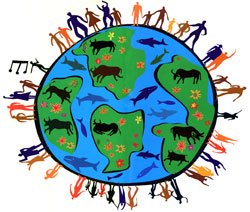We’re all about diversity here at Lee & Low, and we know that diversity means more than just race. It’s Lesbian, Gay, Bisexual, and Transgender Pride Month, and we’re wondering what our readers would think about picture books portraying the growing number of families led by same-sex parents—would you buy or review picture books featuring same-sex parents, whether for your library, classroom, kids, or personal collection?
This Week in Diversity: American Geography
 Oh, Arizona. Why are so many things happening in your beautiful state lately that give us reason to talk about you in these roundups? This time around, it’s a mural featuring the faces of local schoolchildren—but the schoolchildren are a diverse crowd, the mural was drawing racist slurs, and the school’s principal asked for a prominent Latino face to be lightened on the mural. He’s since reversed the decision, and the mural will stay. The Atlantic Wire has a good summary of the situation and the response to it.
Oh, Arizona. Why are so many things happening in your beautiful state lately that give us reason to talk about you in these roundups? This time around, it’s a mural featuring the faces of local schoolchildren—but the schoolchildren are a diverse crowd, the mural was drawing racist slurs, and the school’s principal asked for a prominent Latino face to be lightened on the mural. He’s since reversed the decision, and the mural will stay. The Atlantic Wire has a good summary of the situation and the response to it.
The repercussions of Arizona’s anti-immigration law are still rippling outward. RaceWire elaborates with a look at the disappearing schoolchildren, as parents, particularly illegal immigrants, are keeping their kids—often natural-born citizens themselves—at home to protect the family.
Video Thursday: Illegal European Immigrants
Via Stuff White People Do, a different perspective on Arizona’s new immigration law:
Are Books (and E-Books) Green?
There are plenty of books out now teaching us to respect the environment. But do they do it themselves? The question of whether books are “green” tends to make readers more than a little uncomfortable, because much as we all love the feel of leafing through a book, hey, that’s a lot of trees. So, just how environmentally friendly are books? Here’s what you need to know (thanks to our Production Manager, Danny, for the full rundown):
book, hey, that’s a lot of trees. So, just how environmentally friendly are books? Here’s what you need to know (thanks to our Production Manager, Danny, for the full rundown):
1. Books are meant to be kept. On the pro side, books have a rather longer shelf life than, well, most things. They don’t need to be thrown out when we’re done with them, won’t break or expire. And if you don’t want them, there’s always a need for them somewhere else – a school or local library – so books don’t end up in landfills like most other things. That’s good.
2. The paper used in the manufacturing process comes from trees meant for paper. Book paper mostly comes from tree farms, not irreplaceable 500-year-old trees. Tree farms feature fast-growing, replenishable trees that are less expensive to log and maintain, and easier to implement in an industrialized setting.
Oprah!
 Well, this is exciting! Oprah’s Book Club just released its 2010 Kids’ Reading List, full of books recommended by the American Library Association—and our very own Tofu Quilt makes an appearance!
Well, this is exciting! Oprah’s Book Club just released its 2010 Kids’ Reading List, full of books recommended by the American Library Association—and our very own Tofu Quilt makes an appearance!
Rock On!

Childhood is Once
I was reading a manuscript the other day, and there was a part that made me laugh because it could have been a page pulled from my childhood. The scene was between best friends, sharing a carefree, endless summer day with a good old exchange of one-upmanship. It’s amazing how a children’s book can remind you of the person you used to be.
I have always been attracted to things that allow me, in small ways, to retain parts of my childhood, whether they are the books I read, the movies I see, or the music I listen to. Being an adult does not afford one the freedom to act like a child, as the responsibilities of life do not allow for many carefree, endless summer days. But being able to relive parts of your childhood through conscious choices of literature or other media can keep the child within alive. I think this is a terrific way to approach life, since we each get only one chance to be a child, and everyone knows that childhood is very brief compared to the years one must spend acting like an adult.
This Week in Diversity: Memorial Day Edition
Book Expo America has finished and Memorial Day is almost here, but in between, here’s your weekly batch of diversity reading!
Looking back to the era of Civil Rights protests and Civil Rights legislation, Breach of Peace presents some amazing portraits of some of the 1961 Freedom Riders—with their mugshots, recent interviews, and recent photos. Some amazing stories here. Meanwhile, an editorial at the Washington Post looks at the 1964 Civil Rights act and government support of private segregation.
Video Thursday: Unthinkable
Via RaceWire, a new music video from Alicia Keys showcases an interracial relationship—and facing the condemnation of friends and families as a result.
Teaching Children Diversity Should Start at a Young Age
Children become aware of gender, race, ethnicity, and disabilities before entering kindergarten. They form views at a young age, absorbing any bias or judgments from the adults in their life. It is important for parents to teach their children how to respect and appreciate others, creating a positive habit to take throughout their life.
Creating an environment for children to interact with kids from other backgrounds and cultures is important to their healthy development. It allows them to see the differences among each other and value them, instead of judging or turning away.

